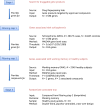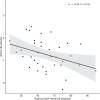The effect of fampridine on working memory: a randomized controlled trial based on a genome-guided repurposing approach
- PMID: 39516710
- PMCID: PMC12014476
- DOI: 10.1038/s41380-024-02820-1
The effect of fampridine on working memory: a randomized controlled trial based on a genome-guided repurposing approach
Abstract
Working memory (WM), a key component of cognitive functions, is often impaired in psychiatric disorders such as schizophrenia. Through a genome-guided drug repurposing approach, we identified fampridine, a potassium channel blocker used to improve walking in multiple sclerosis, as a candidate for modulating WM. In a subsequent double-blind, randomized, placebo-controlled, crossover trial in 43 healthy young adults (ClinicalTrials.gov, NCT04652557), we assessed fampridine's impact on WM (3-back d-prime, primary outcome) after 3.5 days of repeated administration (10 mg twice daily). Independently of baseline cognitive performance, no significant main effect was observed (Wilcoxon P = 0.87, r = 0.026). However, lower baseline performance was associated with higher working memory performance after repeated intake of fampridine compared to placebo (rs = -0.37, P = 0.014, n = 43). Additionally, repeated intake of fampridine lowered resting motor threshold (F(1,37) = 5.31, P = 0.027, R2β = 0.01), the non-behavioral secondary outcome, indicating increased cortical excitability linked to cognitive function. Fampridine's capacity to enhance WM in low-performing individuals and to increase brain excitability points to its potential value for treating WM deficits.
© 2024. The Author(s).
Conflict of interest statement
Competing interests: AP and DJ-FdQ are co-founders of GeneGuide AG. This interest had no role in the present trial. The other authors declare no competing interests.
Figures




Similar articles
-
Short-term impact of fampridine on motor and cognitive functions, mood and quality of life among multiple sclerosis patients.Clin Neurol Neurosurg. 2015 Dec;139:35-40. doi: 10.1016/j.clineuro.2015.08.023. Epub 2015 Aug 28. Clin Neurol Neurosurg. 2015. PMID: 26363365 Clinical Trial.
-
The effect of Fampridine-SR on cognitive fatigue in a randomized double-blind crossover trial in patients with MS.Mult Scler Relat Disord. 2017 Jan;11:4-9. doi: 10.1016/j.msard.2016.10.011. Epub 2016 Nov 4. Mult Scler Relat Disord. 2017. PMID: 28104253 Clinical Trial.
-
Assessment of Clinically Meaningful Improvements in Self-Reported Walking Ability in Participants with Multiple Sclerosis: Results from the Randomized, Double-Blind, Phase III ENHANCE Trial of Prolonged-Release Fampridine.CNS Drugs. 2019 Jan;33(1):61-79. doi: 10.1007/s40263-018-0586-5. CNS Drugs. 2019. PMID: 30535670 Free PMC article. Clinical Trial.
-
Predicting responsiveness to fampridine in gait-impaired patients with multiple sclerosis.Eur J Neurol. 2019 Feb;26(2):281-289. doi: 10.1111/ene.13805. Epub 2018 Oct 7. Eur J Neurol. 2019. PMID: 30171655 Clinical Trial.
-
Effects of Fampridine in People with Multiple Sclerosis: A Systematic Review and Meta-analysis.CNS Drugs. 2019 Nov;33(11):1087-1099. doi: 10.1007/s40263-019-00671-x. CNS Drugs. 2019. PMID: 31612418
References
-
- Baddeley A. Working memory. Science. 1992;255:556–9. - PubMed
-
- Shah P, Miyake A. Models of Working Memory: Mechanisms of Active Maintenance and Executive Control. In: Miyake A, Shah P, editors. Models of Working Memory: An Introduction. Cambridge University Press: Cambridge; 1999, pp 1–27.
-
- Weinberger DR, Gallhofer B. Cognitive function in schizophrenia. Int Clin Psychopharmacol. 1997;12:S29–S36. - PubMed
-
- Gold JM, Weinberger DR. Cognitive deficits and the neurobiology of schizophrenia. Curr Opin Neurobiol. 1995;5:225–30. - PubMed
-
- Falkai P, Rossner MJ, Schulze TG, Hasan A, Brzozka MM, Malchow B, et al. Kraepelin revisited: schizophrenia from degeneration to failed regeneration. Mol Psychiatry. 2015;20:671–6. - PubMed
Publication types
MeSH terms
Substances
Associated data
Grants and funding
LinkOut - more resources
Full Text Sources
Medical

